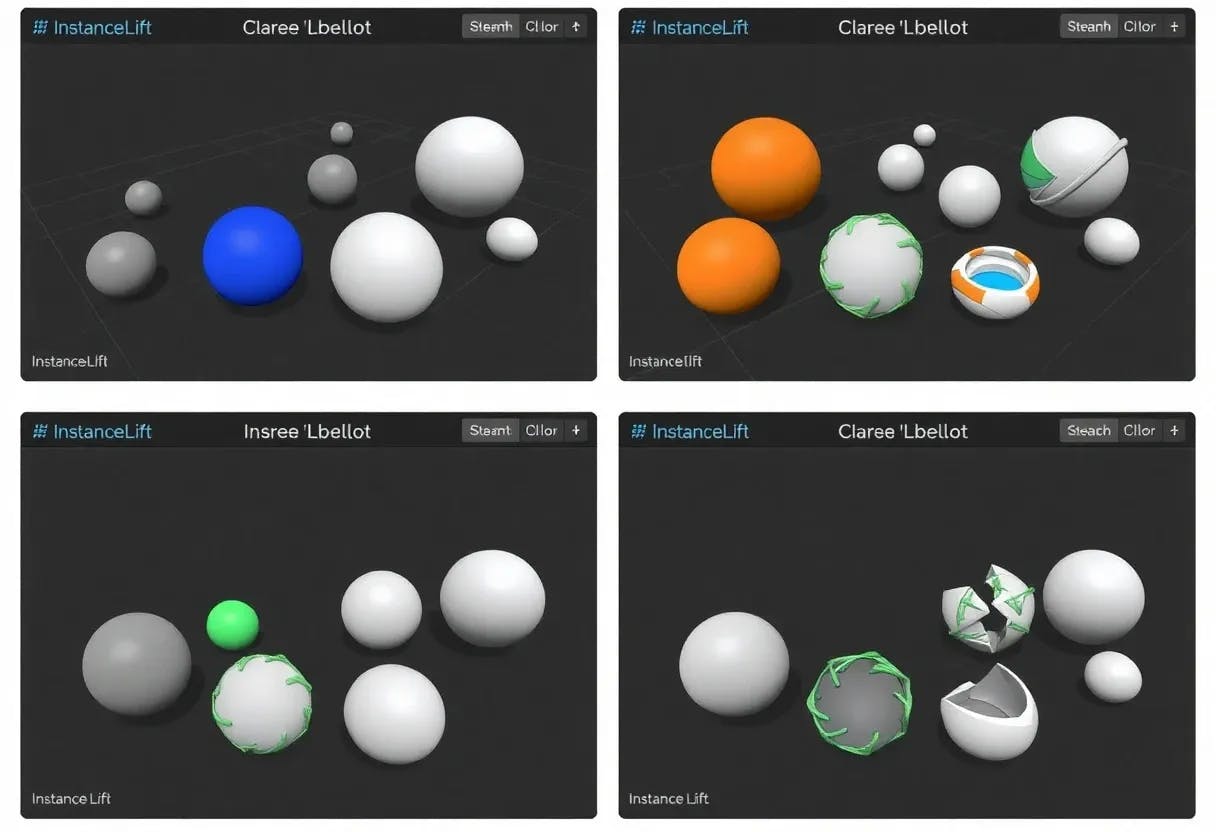Deeper Dive: Our Top Tested Picks
EDITORS’ NOTE
August 21, 2025: With this update, we added the Alienware 25 (AW2525HM) as Best Cheap Gaming Monitor for 1080p Play, replacing the BenQ Mobiuz EX2510S. Since our last update, we have tested and evaluated 26 monitors for possible inclusion in this roundup and our other monitor roundups.
Best Cheap Gaming Monitor for Most People
ViewSonic Omni VX2728J-2K
- Affordable
- Excellent color range for the price
- Surprisingly high color accuracy
- Lightweight
- No HDMI 2.1 port
- Flimsy tripod-style stand
- No USB ports
- Limited HDR capabilities
Who says a gaming monitor has to be expensive to be good? The ViewSonic Omni VX2728J-2K punches well above its weight, delivering a QHD screen, a 180Hz refresh rate, a 0.5ms response time, and AMD FreeSync Premium technology to eliminate screen tearing and stuttering. This ViewSonic monitor might not have the flashy add-ons of more expensive gaming monitors, it’s short on I/O ports, and we’re not a fan of the tripod stand. But if you’re willing to look past these faults, you’ll find a very dependable (and very affordable) gaming monitor.
If you’re looking for a gaming monitor that offers the most bang for your buck, the ViewSonic Omni VX2728J-2K is right for you.
Panel Size (Corner-to-Corner)
27 inches
Native Resolution
2560 by 1440
Aspect Ratio
16:9
Screen Technology
IPS
Rated Screen Luminance
250 nits
Rated Contrast Ratio
1000:1
Pixel Refresh Rate
180 Hz
Adaptive Sync
AMD FreeSync Premium
Video Inputs
DisplayPort, HDMI
VESA DisplayHDR Level
HDR10
Dimensions (HWD)
22.36 by 24.2 by 8.1 inches
Weight
10.7 lbs
Warranty (Parts/Labor)
3 years
Learn More
ViewSonic Omni VX2728J-2K Review

Best Cheap Gaming Monitor for 1080p Play
Alienware 25 320Hz Gaming Monitor (AW2525HM)
- Aggressively low price
- Rock-solid gaming performance, high peak refresh for the money
- Surprisingly wide color range
- Retractable headset hanger
- Lackluster HDR experience
- No internal speakers or headphone jack
The Alienware AW2525HM offers a high refresh rate of 320Hz on a 1080p screen. It also has a 0.5ms rated response time and robust anti-tearing support (it’s AMD FreeSync Premium, VESA AdaptiveSync, and Nvidia G-Sync compatible), so it’s ideal for intense gaming sessions. But the low input lag across a variety of frame rates really prepares the Alienware AW2525HM for just about every situation. Outside of gaming performance, the monitor has a surprisingly wide color range, as well as additional gamer-friendly add-ons like a retractable headset hanger. For a pauper’s price, the AW2525HM delivers the basics and more to earn our top recommendation for everyday 1080p gaming
For those who want a monitor that just works, the AW2525HM delivers plenty at a very affordable price.
Panel Size (Corner-to-Corner)
25 inches
Native Resolution
1920 by 1080
Aspect Ratio
16:9
Screen Technology
Fast IPS (FIPS)
Rated Screen Luminance
400 nits
Rated Contrast Ratio
1,000:1
Pixel Refresh Rate
320 Hz
Adaptive Sync
AMD FreeSync Premium, VESA AdaptiveSync, NVIDIA G-Sync compatible
Video Inputs
HDMI (2), DisplayPort
USB Ports (Excluding Upstream)
2
VESA DisplayHDR Level
NA
Dimensions (HWD)
15.3 by 21.8 by 8.1 inches
Weight
13.3 lbs
Warranty (Parts/Labor)
3 years
Learn More
Alienware 25 320Hz Gaming Monitor (AW2525HM) Review

Best Cheap Gaming Monitor for 4K Play
HP Omen 27k
- Excellent contrast ratio
- High brightness
- Built-in KVM switch
- Clean, good looking design
- Subpar speakers
- Color range could be better
- Only one HDMI 2.1 port
The HP Omen 27k is a capable and affordable 4K gaming monitor. With two HDMI ports (one 2.0 and one 2.1), a DisplayPort 1.4, and one USB Type-C (which can also be used as a DisplayPort input), the monitor offers plenty of I/O options for console and PC players. The 144Hz refresh rate is low when compared with other premium gaming monitors, but it’s good enough for gamers who want to play at maximum resolution and frame rates between 60 and 120 frames per second. The color accuracy and low input lag make up for the weaker color range and lame speakers, which means that overall, the HP Omen 27k is an excellent 4K monitor, especially considering its affordable price.
If you’re in the market for a decent 4K monitor, you’ll find the HP Omen 27k to be a harbinger of enjoyable 4K gaming.
Panel Size (Corner-to-Corner)
27 inches
Native Resolution
3840 by 2160
Aspect Ratio
16:9
Screen Technology
IPS
Rated Screen Luminance
400 nits
Rated Contrast Ratio
1000:1
Pixel Refresh Rate
144 Hz
Adaptive Sync
AMD FreeSync Premium, Nvidia G-Sync Compatible
Video Inputs
DisplayPort, USB-C, HDMI (2)
USB Ports (Excluding Upstream)
2
VESA DisplayHDR Level
DisplayHDR 400
Dimensions (HWD)
20.62 by 8.79 x by 24.16 inches
Weight
16.6 lbs
Warranty (Parts/Labor)
1 year
Learn More
HP Omen 27k Review

Best Cheap Gaming Monitor for 1440p Play
HP Omen 32q
- Aggressively priced for a big 1440p panel
- Super-low input lag
- Solid brightness and HDR measurements for the money
- No built-in speakers
- No HDMI 2.1 port or additional USB ports
The HP Omen 32q is a relatively simple 31.5-inch QHD monitor that doesn’t do much out of the ordinary, but it’s still a more-than-respectable gaming monitor. Complete with a 165Hz refresh rate and surprisingly solid color accuracy, the HP Omen 32q might be a lesser demon, but one that’s worth looking into if you seek a monitor to pair with a mainstream PC or console. Like many other cheap monitors, the Omen 32q doesn’t come with many I/O ports, but its low input lag makes it a decent display for both casual and hardcore play.
The HP Omen 32q is a dependable 1440p monitor for pairing with mainstream PCs and consoles.
Panel Size (Corner-to-Corner)
32 inches
Native Resolution
2560 by 1440
Aspect Ratio
16:9
Screen Technology
IPS
Rated Screen Luminance
400 nits
Rated Contrast Ratio
1000:1
Pixel Refresh Rate
165 Hz
Adaptive Sync
AMD FreeSync Premium
Video Inputs
DisplayPort, HDMI
VESA DisplayHDR Level
DisplayHDR 400
Dimensions (HWD)
16.78 by 28.09 by 2.07 (HWD) inches
Weight
19.8 lbs
Warranty (Parts/Labor)
1 year
Learn More
HP Omen 32q Review

Best Cheap Curved Monitor for Gaming
Samsung 24-Inch CF396 Curved LED
- Curved screen
- Great sRGB color coverage
- Bright for a budget monitor
- Mini-joystick controller
- Sparse port selection
- Stand limits you to tilt adjustment
- Meager one-year warranty
Wearing a slight curve of just 1,800R, the CF396 Curved LED Monitor is the most basic of monitors. But the small screen is not without its perks. Not out of place in a home, office, or living room, the curved screen offers excellent color coverage for a monitor this cheap. It’s not much of a gaming monitor, with a refresh rate maximum of just 60Hz, but it’s small, lightweight, and supports AMD FreeSync. Don’t expect miracles from this tiny monitor, but if you’re looking for a basic curved monitor to game on, the CF396 Curved LED Monitor delivers the goods at a very agreeable price.
The CF396 is for gamers interested in a curved monitor but not interested in investing a lot of cash.
Panel Size (Corner-to-Corner)
23.5 inches
Native Resolution
1920 by 1080
Aspect Ratio
16:9
Screen Technology
VA
Rated Screen Luminance
250 nits
Rated Contrast Ratio
3000:1
Pixel Refresh Rate
60 Hz
Adaptive Sync
AMD FreeSync
Video Inputs
HDMI, VGA
VESA DisplayHDR Level
NA
Dimensions (HWD)
16.7 by 21.6 by 8.6 inches
Weight
6.8 lbs
Warranty (Parts/Labor)
1 year
Learn More
Samsung 24-Inch CF396 Curved LED Review

Best Cheap Ultrawide Monitor for Gaming
Cooler Master GM34-CWQ ARGB
- Attractive design
- Great color results out of the box
- Solid contrast ratio
- Affordable price
- RGB lights must be plugged in to work
- Limited height adjustment
- Sensitive OSD joystick
Cooler Master might not be known for ultrawide monitors, but the GM34-CWQ ARGB is a more-than-capable gaming display for an affordable price. The GM34-CWQ delivers a captivating curve at a digestible price point, offering an impressive color range and feature set right out of the box. The 3,440-by-1,440-pixel 34-inch ultrawide monitor is heavy on I/O ports, with two USB Type-A ports, a USB Type-C connector, and a Type-B port. That makes the monitor a capable productivity monitor as well as one for gaming. Great color range and color accuracy round out the package.
The Cooler Master GM34-CWQ ARGB is an incredible ultrawide monitor for people who want to maximize immersion and minimize expense.
Panel Size (Corner-to-Corner)
34 inches
Native Resolution
3440 by 1440
Aspect Ratio
21:9
Screen Technology
VA
Rated Screen Luminance
400 nits
Rated Contrast Ratio
4000:1
Pixel Refresh Rate
144 Hz
Adaptive Sync
AMD FreeSync Premium
Video Inputs
DisplayPort, HDMI
USB Ports (Excluding Upstream)
4
VESA DisplayHDR Level
DisplayHDR 400
Dimensions (HWD)
17.1 by 31.7 by 10.8 inches
Weight
21.8 lbs
Warranty (Parts/Labor)
3 years
Learn More
Cooler Master GM34-CWQ ARGB Review

Best Cheap Monitor for Esports Games
Gigabyte M27Q X
- Low input lag
- KVM functionality
- Lightweight build
- Affordable price
- Good color-gamut results
- Low brightness and contrast ratio at default screen setting
- Stand is noisy
If you care about competitive gaming, chances are you care about refresh rate over resolution. The Gigabyte M27Q X offers a surprisingly attractive middle ground: a QHD screen with a 240Hz refresh rate. What it lacks in esports-focused gameplay-improving features, the 27-inch monitor makes up for with a high refresh rate and low input lag. The Gigabyte is not without its problems: It takes some tinkering to get the default brightness and contrast ratio to play nice, but otherwise, for the price, you’ll find no other monitor like the M27Q X.
If you’re looking for a cheap monitor for competitive play, the Gigabyte M27Q X will serve you well.
Panel Size (Corner-to-Corner)
27 inches
Native Resolution
2560 by 1440
Aspect Ratio
16:9
Screen Technology
Super Speed IPS
Rated Screen Luminance
350 nits
Rated Contrast Ratio
1000:1
Pixel Refresh Rate
240 Hz
Adaptive Sync
AMD FreeSync
Video Inputs
HDMI, DisplayPort
USB Ports (Excluding Upstream)
3
VESA DisplayHDR Level
DisplayHDR 400
Dimensions (HWD)
21 by 24.2 by 7.6 inches
Weight
11.6 lbs
Warranty (Parts/Labor)
3 years
Learn More
Gigabyte M27Q X Review

Best Cheap Portable Gaming Monitor
ViewSonic VX1755
- Excellent build quality
- Fair price for the size
- Low input lag
- Lightweight
- Disappointing color gamut and color accuracy results
- Can’t control volume without navigating OSD
The ViewSonic VX1755 is 17.2-inch portable monitor that’s perfect for gamers looking for a dependable screen for gaming on the go. Offering excellent build quality and low input lag, this is a 1080p 144Hz screen that will go anywhere you want to take it. Also included: a magnetic cover that does a great job of covering the screen, while the wide stand offers ample screen support. Disappointing color gamut and color accuracy results damper the overall experience, but the mini monitor is still plenty useful in a pinch, and its price is easy on the wallet.
if you’re in the market for a lightweight monitor that’s small enough to tuck into a bookbag to go along with your console or gaming laptop, you can’t go wrong with the ViewSonic VX1755.
Panel Size (Corner-to-Corner)
17.2 inches
Native Resolution
1920 by 1080
Aspect Ratio
16:9
Screen Technology
IPS
Rated Screen Luminance
250 nits
Rated Contrast Ratio
800:1
Pixel Refresh Rate
144 Hz
Adaptive Sync
FreeSync Premium
Video Inputs
USB-C, mini HDMI
USB Ports (Excluding Upstream)
1
VESA DisplayHDR Level
NA
Dimensions (HWD)
9.7 by 15.6 by 0.7 inches
Weight
2.2 lbs
Warranty (Parts/Labor)
3 years
Learn More
ViewSonic VX1755 Review

Get Our Best Stories!
All the Latest Tech, Tested by Our Experts

By clicking Sign Me Up, you confirm you are 16+ and agree to our Terms of Use and Privacy Policy.
Thanks for signing up!
Your subscription has been confirmed. Keep an eye on your inbox!
The Best Cheap Gaming Monitors for 2025
Compare Specs
Buying Guide: The Best Cheap Gaming Monitors for 2025
When it comes to budget gaming monitors, the size of your panel and its resolution are intertwined. Native resolution has traditionally been limited to 1080p (1,920 by 1,080 pixels) in monitors under 32 inches in panel size.
That’s changing, though, as more manufacturers broaden their range of available models. We’ve been able to include both 1440p (2,560 by 1,440 pixels) and 4K (3,840 by 2,160 pixels) options in this roundup, and that diversity will only continue to grow as the economics of panel production follow the natural curve of tech product cycles: bigger, better, cheaper.

(Credit: Joseph Maldonado)
In our testing across the budget gaming monitor market over the past few years, we’ve seen three size categories take hold as staples: 24-inch, 27-inch, and 32-inch. While other size offerings lie above and below those goalposts, these three are the most commonly produced by many of the major manufacturers, with 25-inchers as an occasional interloper.
Who wants the smaller sizes? Space-strapped folks, sure, but also a surprising contingent: esports professionals. In general, we recommend starting any serious gaming career by looking at 24-inch panels, as this is the most popular option for esports pros around the world. It’s considered just large enough to fill your field of vision, but not so large that you lose details on the periphery. If you take your multiplayer matches seriously, 24-inchers are a pro-approved starting point, and some might argue exactly as large as you should go.

(Credit: Joseph Maldonado)
For those who want a slightly more cinematic experience and play a mix of AAA titles and low-intensity multiplayer games (and who also watch a lot of content at their desks), the 27-inch and 32-inch brackets fill their respective roles better, in our opinion. Generally speaking, however, expect to pay more at these size tiers. The economics of panel production in the current marketplace, along with the raw cost of materials, both can have an effect on the final list price of a monitor.
Perhaps the most determinate factor in the price of your next gaming monitor, though, is the type of panel packed inside. Let’s get into that.
Which Panel Technology to Get in a Cheap Gaming Monitor?
The reason we didn’t present you with a straight pricing chart above—one that tells you specifically what you should expect to spend for what size of panel—is because the type of panel also helps determine a gaming monitor’s price range. As you shop, you’ll see several different panel technologies out there, and each has its own set of benefits and drawbacks.
Twisted Nematic (TN)
TN panels are often the most affordable of all the types we’ll discuss in this section. They are popular among gamers because they offer fast pixel response times and refresh rates. The downsides of TN? TN panels can exhibit low brightness levels and poor contrast, and they aren’t generally a good choice for general content watching or if you want AAA games to “pop,” as it were. Think of TN’s role as the ultimate budget driver for games like Counter-Strike: Global Offensive or League of Legends, and not a whole lot more.
Vertical Alignment (VA)
VA screens are known for their high native contrast ratios, robust colors, and ability to display deep blacks. But they are also known to produce noticeable ghosting effects, which can mar multiplayer gaming performance. If you’re more of a AAA gamer who doesn’t need response times that break records, and who prefers color vividness to outright speed, VA will be your best bet in the budget segment.
In-Plane Switching (IPS)
IPS panels provide the best all-around color quality, as well as strong grayscale performance and wide viewing angles. But they can’t match the pixel response of TN panels and can be subject to motion artifacts. They are the best general-use panel type, but discriminating gamers and competitive esports types may take issue with IPS panels.
Fast IPS (FIPS)
Some newer technology changed the IPS narrative in 2019, when LG developed a new IPS panel type, which various monitor makers may dub “Nano IPS” or “Fast IPS” or something else, depending on the company. FIPS claims 1-millisecond gray-to-gray response time with overdrive turned on. These panels use a thin layer of nanoparticles applied to the display’s backlight that enables wider color-gamut coverage and reduces response times, a combination that makes them the now-dominant choice for almost every midrange and premium gaming monitor. If you have room in your budget, they offer the best balance of gaming performance to image quality nowadays.
For the true budget gamer, if you spot any FIPS or Nano IPS monitor on sale and it fits within your price range, push it to the top of your list. Even the worst FIPS- or Nano IPS-backed panels we’ve tested are well ahead of the best VA or TN panels in color quality, response times, and input lag figures.

(Credit: Joseph Maldonado)
Organic Light Emitting Diode and Quantum Dot OLED (OLED, QD-OLED)
OLED panels still remain squarely ultra-premium picks (as do the QD-OLED versions that have trickled out over the past year). We don’t foresee them in budget models anytime soon. Just like with OLED televisions, these two ultra-beautiful panel types are inescapably expensive to produce (for now), and the few OLED gaming monitors that even exist are anything but cost-conscious.
Specs to Watch: Pixel Response, Input Lag, and Refresh Rate
Gaming monitors at the budget level need to make compromises on aspects like panel type. Many of the specs important to gaming monitors that have usually been strong only on premium models—input lag and pixel response time, for starters—have gotten a lot better with the budget set of late. (Our overall gaming monitors guide gets deeper into the background of what these specs mean.)
Some of the best budget monitors we’ve tested in the past year also have some of the lowest input-lag figures. Also, while models with ultra-high refresh rates remain a bit pricey despite their 1080p native resolution, plenty come in at quite affordable prices, while putting up stellar gaming performance results across the board.

(Credit: Kyle Cobian)
Overall, in the budget tier for gaming monitors—which starts to transition into mid-tier around $350 to $400 these days, depending on who you ask and what screen size you are talking about—you should set your spec expectations as follows. For refresh rate, expect the spec to be from 100Hz to 165Hz, though some 200Hz and 240Hz models go on sale every now and then and create exceptions to the rule.
Then there’s response time: Your new budget panel should maintain gray-to-gray response times of 1-millisecond (1ms) or less. And as for input-lag figures, they can drift below 3ms comfortably without hurting your wallet too much (or your multiplayer ranking, if you’re an esports hound).
Adaptive Sync and HDR: Are They Worth Paying For?
Before we close out this guide, know that two other features can pump up the cost of a gaming monitor, but you might want them anyway: support for an adaptive sync anti-screen-tearing technology, as well as for high-dynamic range (HDR) content.
Adaptive sync encompasses a couple of technologies from AMD (FreeSync) and Nvidia (G-Sync), the two big video card makers. Adaptive sync’s job is to smooth out distracting “screen tearing,” which is misaligned, partially drawn portions of your screen that occasionally occur. FreeSync and G-Sync each come in one of several “levels” of capability, depending on the monitor.

(Credit: Kyle Cobian)
Where you do see adaptive sync in a budget monitor at all (not all have it), AMD’s FreeSync tends to be more common. The upper levels of G-Sync, like G-Sync Ultimate (which require specialized circuitry in the monitor), cost extra and aren’t in budget monitors. Your make of graphics card determines which of these technologies you can use, but know that some FreeSync monitors are also what’s called “G-Sync Compatible,” which means their adaptive-sync feature will work with GeForce cards, too. Nvidia maintains a list of G-Sync Compatible monitors here. (See our general gaming monitors guide for more on these technologies.) For a budget gaming monitor, to leverage the feature, you’ll want to check that you have adaptive sync support that matches your video card’s, though the panel will still work, either way.
HDR is less essential a creature comfort for gamers, more geared toward enhancing color and brightness. HDR specs are defined by their own set of “levels” that express the intensity of the effect, and higher HDR specs tend to reflect how expensive your monitor might get.
You will see HDR 400-rated monitors floating around the budget-display category, but more often than not, you’re better off without it, or at least not paying more for it. HDR doesn’t start producing eye-popping visuals until the HDR 600 mark, and it’s only really worth the ticket price at HDR 1000 and above, to our eyes. We’ve laid eyes on a lot of “budget HDR” panels over the past few years, and while a few monitors on our pick list do HDR 400, they have strong reasons to be there unrelated to the HDR support. (See much more about monitor HDR in Windows in our primer.)
Our general buying advice in this department? Go for the highest rating of compatible adaptive sync you can fit within your budget, and mostly ignore HDR as a sideshow. We’ve yet to see an HDR 400 budget monitor that merits an “HDR” designation at all. Conversely, plenty of budget gaming panels with FreeSync or G-Sync Compatible badges are great entry points for aspiring esports pros, or those who want a little more smoothness in their AAA gaming experience.
Ready to Buy the Right Cheap Gaming Monitor for You?
Finding the best budget gaming monitor is all about compromise, but that’s no bad thing. Balancing the right panel type at the right size, with the right refresh rate, will come down to personal preference and the kinds of games you like to play most. For more of our monitor picks, check out our top gaming monitors overall, regardless of price level. Gamers can also check out our top-picks coverage of other peripherals such as gaming keyboards and gaming mice to complete their PC gaming package.










